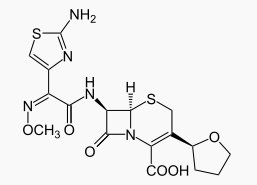Cefovecin
 | |
| Clinical data | |
|---|---|
| AHFS/Drugs.com | International Drug Names |
| Pregnancy category |
|
| Routes of administration | dorsoscapular subcutaneous injection |
| ATCvet code | |
| Legal status | |
| Legal status |
|
| Pharmacokinetic data | |
| Protein binding | Dogs: 98.5%, Cats: 99.8% |
| Metabolism | none |
| Elimination half-life | Dogs: 133 hours, Cats: 166 hours |
| Excretion | unchanged in urine/bile |
| Identifiers | |
| |
| CAS Number | |
| PubChem CID | |
| ChemSpider | |
| UNII | |
| ChEMBL | |
| E number | {{#property:P628}} |
| ECHA InfoCard | {{#property:P2566}}Lua error in Module:EditAtWikidata at line 36: attempt to index field 'wikibase' (a nil value). |
| Chemical and physical data | |
| Formula | C17H19N5O6S2 |
| Molar mass | 453.49 g/mol |
| 3D model (JSmol) | |
| |
| |
| | |
|
WikiDoc Resources for Cefovecin |
|
Articles |
|---|
|
Most recent articles on Cefovecin |
|
Media |
|
Evidence Based Medicine |
|
Clinical Trials |
|
Ongoing Trials on Cefovecin at Clinical Trials.gov Clinical Trials on Cefovecin at Google
|
|
Guidelines / Policies / Govt |
|
US National Guidelines Clearinghouse on Cefovecin
|
|
Books |
|
News |
|
Commentary |
|
Definitions |
|
Patient Resources / Community |
|
Patient resources on Cefovecin Discussion groups on Cefovecin Directions to Hospitals Treating Cefovecin Risk calculators and risk factors for Cefovecin
|
|
Healthcare Provider Resources |
|
Causes & Risk Factors for Cefovecin |
|
Continuing Medical Education (CME) |
|
International |
|
|
|
Business |
|
Experimental / Informatics |
Editor-In-Chief: C. Michael Gibson, M.S., M.D. [1]
Overview
Cefovecin (INN) is an antibiotic of the cephalosporin class, licensed for the treatment of skin infections in cats and dogs. It is marketed by Zoetis under the trade name Convenia. It is the first single-dose injectable antibiotic for dogs and cats that assures owner compliance with dosing for the animal. It is used for the treatment of skin infections caused by Pasturella multocida in cats, and Streptococcus intermedius/S. canis in dogs. The advantage of using injectable antibiotics is not missing a dose that can allow partially resistant microbes to recover during missed doses. It is highly effective, but should not be used in pregnant or lactating animals or in animals with a history of allergies to penicillin or cephalosporin drugs.[1]
Approval and usage
Cefovecin was first authorized for use in the European Union in June 2006,[2] and was approved for use in the United States in June 2008.[3]
It is approved as a broad-spectrum, fourth-generation cephalosporin for subcutaneous injection lasting 14 days for treating skin and soft tissue infections.[4]
Precautions
Contraindications include known allergies to cefovecin or antibiotics containing β-lactam rings such as penicillin or cephalosporins. Adverse reactions can include anaphylaxis. It is not for use in humans and should be kept out of reach of children. Individuals with similar known allergies should avoid dermal contact when handling the drugs.
Adverse reactions in dogs can include lethargy, decreased appetite, vomiting, diarrhea, blood in feces, and flatulence. Adverse reactions in cats can include vomiting, diarrhea, decreased appetite, lethargy, odd hyperactive behavior, and inappropriate urination. Mildly increased serum ALT and gamma glutamyl transferase have been noted.[5]
Effectiveness
Cefovecin functions by interfering with cell wall synthesis. The chemical covalently binds to the so-called penicillin-binding proteins. Due to the high protein-binding of the chemical, it is not effective against Pseudomonas spp., or enterococci.
In drug studies, cefovecin administered to dogs was 92.4% effective against skin infections (secondary superficial pyoderma, abscesses, and infected wounds). In cats, it was 96.8% effective against skin infections.[6]
References
- ↑ Pfizer Animal Health. "Pfizer Convenia" (PDF). Pfizer. Retrieved 29 January 2013.
- ↑ "European Public Assessment Report for Convenia (from the EMEA website)". Retrieved 2008-07-11.
- ↑ "FDA Approves First and Only Single-dose Antibiotic for Dogs and Cats" (Press release). Pfizer Inc. 2008-06-30. Retrieved 2008-07-11.
- ↑ Pfizer Animal Health. "Convenia". Pfizer. Retrieved 29 January 2013.
- ↑ Pfizer Animal Health. "Pfizer Convenia" (PDF). Pfizer. Retrieved 29 January 2013.
- ↑ Pfizer Animal Health. "Pfizer Convenia" (PDF). Pfizer. Retrieved 29 January 2013.
External links
- Template:PubChem - Cefovecin sodium
- Official website by Pfizer
- Pages with script errors
- Template:drugs.com link with non-standard subpage
- Drugs with non-standard legal status
- Articles with changed ChemSpider identifier
- Articles with changed EBI identifier
- E number from Wikidata
- ECHA InfoCard ID from Wikidata
- Articles with changed InChI identifier
- Chemical articles with unknown parameter in Infobox drug
- Chemical pages without DrugBank identifier
- Articles without KEGG source
- Drugboxes which contain changes to verified fields
- Drugboxes which contain changes to watched fields
- Drug
- Cephalosporin antibiotics
- Dog medications
- Cat medications
- Tetrahydrofurans
- Thiazoles
- Oximes